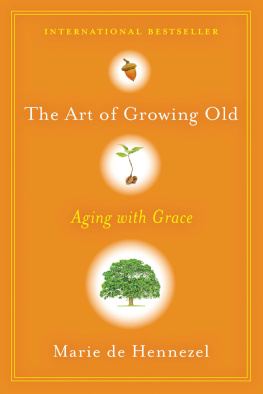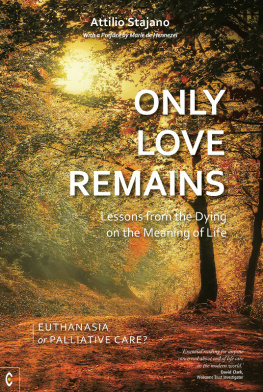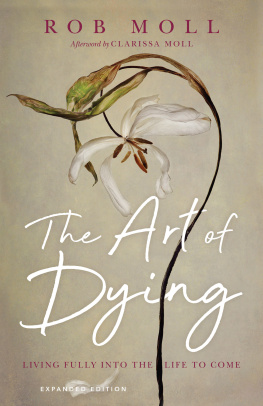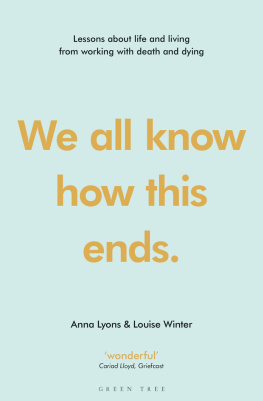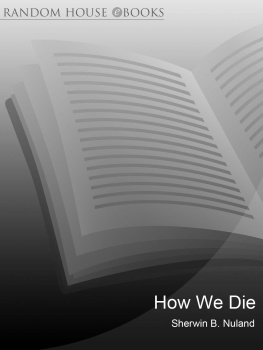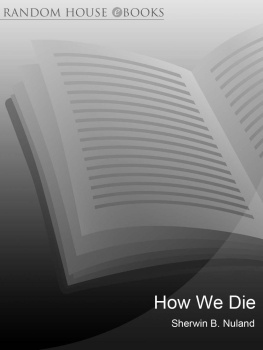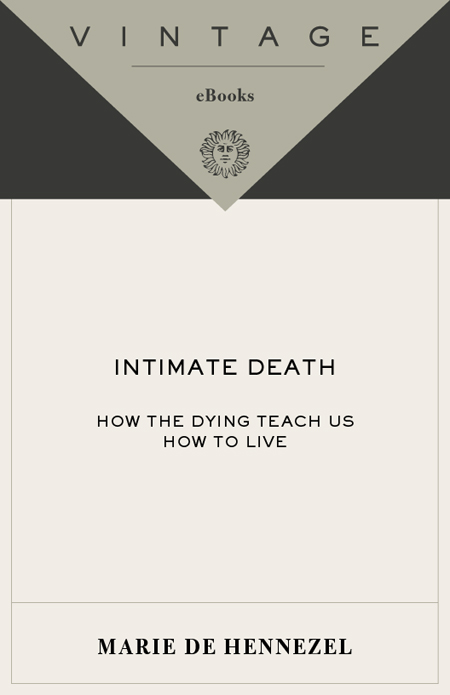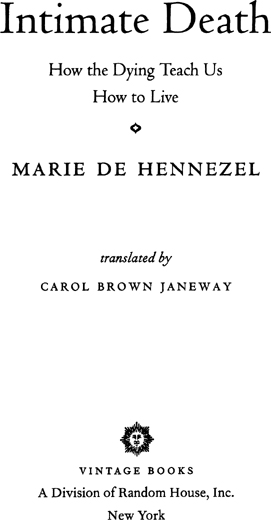MARIE DE HENNEZEL
Intimate Death

Marie de Hennezel was born in France in 1946. She started her career as a psychologist working with women in distress and with cases of advanced psychosis. In 1987, she joined the staff of the first palliative care unit in a Paris hospital for people with terminal illnesses, where she gathered the experiences she describes in this book. She founded the Bernard Dutant Association: AIDS and Re-Empowerment in 1990, in memory of a friend who died of AIDS, and gives lectures on approaching the end of life and seminars on accompanying the dying. She lives in Paris with her husband and three children.
to Laure, Edouard, and Jean

Foreword
H OW DO we learn to die?
We live in a world that panics at this question and turns away. Other civilizations before ours looked squarely at death. They mapped the passage for both the community and the individual. They infused the fulfillment of destiny with a richness of meaning. Never perhaps have our relations with death been as barren as they are in this modern spiritual desert, in which our rush to a mere existence carries us past all sense of mystery. We do not even know that we are parching the essence of life of one of its wellsprings.
This book is a lesson in living. The light it casts is more intense than that of many philosophical treatises; it does not offer thought but, rather, bears witness to the most profound of all human experiences. Its power derives from facts and from the simple way these are represented. Represented is exactto render present again that which escapes our awareness: the far side of things and of time, the heart of anguish and of hope, the suffering of another, the eternal dialogue between life and death.
It is this dialogue that represents itself in these pages, the dialogue that Marie de Hennezel sustains unbrokenly with her dying patients.
I WILL never forget the visit I made to the palliative care unit to which she was currently devoting her energies. I was aware of her work, and we had talked about it from time to time. I was immediately struck by the sense both of strength and of gentleness in her words, a sense I had again when I met the doctors and nurses on her team. They talked to me about their passion, their efforts, government delays, the hurdles still to be overcome. Then they took me to the bedsides of the dying. What was the secret of these men's and women's serenity?
What was the source of the peace in their eyes? Each face imprinted itself on my memory like the face of eternity itself.
It is Daniele's I see again, perhaps because of her youth and her silence. Paralyzed, unable to speak, she could communicate only by blinking her eyelids or using the one finger she could still move to tap at letters on a computer screen. And yet, despite this utter helplessness, she was full of life, full of curiosity about the other side, which she was about to enter without the help of religious faith.
Marie de Hennezel tells us about the dignity of Daniele's last moments and those of her companions in sickness; she also tells us modestly but therefore all the more movingly about the unwavering supportiveness of the teams who accompany them on their last journey. She lets us experience the everyday adventure of the discovery of another human being, the engaging of love and compassion, the courage in the gentle movements that tend these damaged bodies. She shows how it is the love of life, not any death wish, that feeds the choices they make and the things they do.
We have talked about these matters often. I asked her question after question about the sources of the power that erases anguish and brings peace, and about the extraordinary transformations she sometimes witnesses in people who are about to die.
At the moment of utter solitude, when the body breaks down on the edge of infinity, a separate time begins to run that cannot be measured in any normal way. In the course of several days sometimes, with the help of another presence that allows despair and pain to declare.themselves, the dying seize hold of their lives, take possession of them, unlock their truth. They discover the freedom of being true to themselves. It is as if, at the very culmination, everything managed to come free of the jumble of inner pains and illusions that prevent us from belonging to ourselves. The mystery of existence and death is not solved, but it is fully experienced.
That is perhaps the most beautiful lesson of this book: Death can cause a human being to become what he or she was called to become; it can be, in the fullest sense of the word, an accomplishment.
And then, is there not some fragment of eternity in humankind, something that death brings into the world, gives birth to? From the paralysis of her hospital bed, Daniele has a last message for us: I don't believe in a God of justice, or a God of love. It's too human to be possible. What a lack of imagination! But nor do I believe that we can just be reduced to some bundle of atoms. Whatever tells us that there's something beyond mattercall it soul, or spirit, or consciousness, whatever you preferI believe in the immortality of that. Reincarnation or arriving at an entirely new plane of beingit's discovery by death!
It's all there, in these few words: the body dominated by the spirit, terror conquered by confidence, the fullness of an achieved destiny.
True to Daniele, Marie de Hennezel's work is dense with humanity.
How do we learn to die?
If there is an answer, few accounts can provide it with so strong an inspiration as this one.
Franois Mitterrand

Preface
W E HIDE death as if it were shameful and dirty. We see in it only horror, meaninglessness, useless struggle and suffering, an intolerable scandal, whereas it is our life's culmination, its crowning moment, and what gives it both sense and worth.
It is nevertheless an immense mystery, a great question mark that we carry in our very marrow.
I KNOW that I will die one day, although I don't know how, or when. There's a place deep inside me where I know this. I know I'll have to leave the people I love, unless, of course, they leave me first.
This deepest, most private awareness is, paradoxically, what binds me to every other human being. It's why everyman's death touches me. It allows me to penetrate to the heart of the only true question: So what does my life mean?
Those who are privileged to accompany someone in life's final moments know that they are entering the most intimate of times. Before dying, the person will try to leave his or her essence with those who remaina gesture, a word, sometimes just a look to convey what really counts and what thus far has been lefteither from inability or inarticulacyunsaid.
Death, which we will live to the end one day, which will strike our loved ones and our friends, is perhaps what pushes us not to be content with living on the surface of things and people, pushes us to enter into the heart and depth of them.


